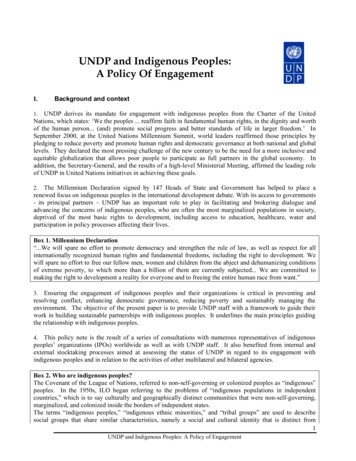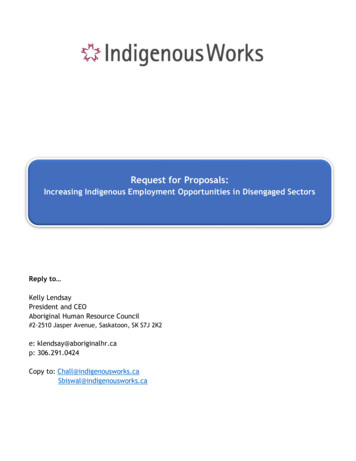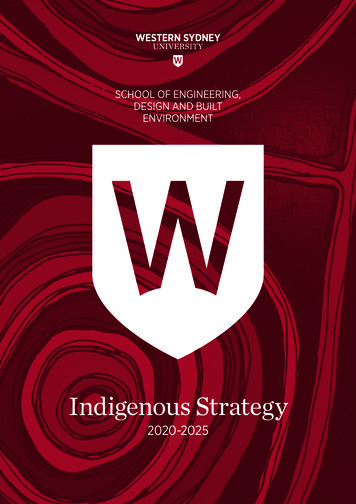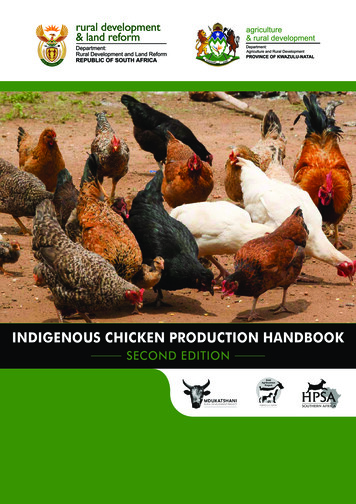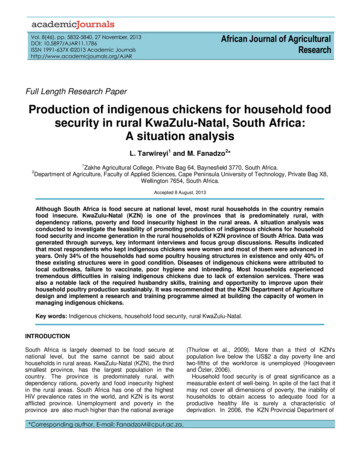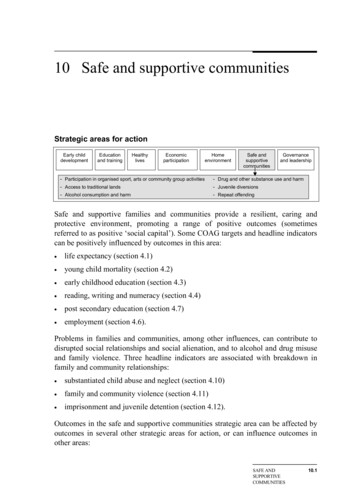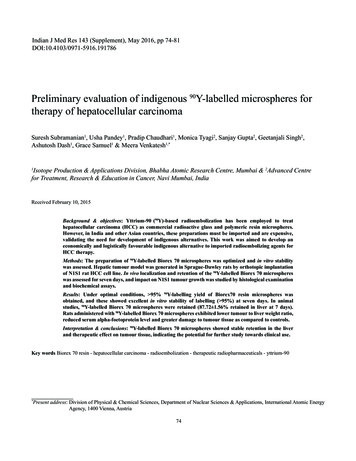
Transcription
Indian J Med Res 143 (Supplement), May 2016, pp 74-81DOI:10.4103/0971-5916.191786Preliminary evaluation of indigenous 90Y-labelled microspheres fortherapy of hepatocellular carcinomaSuresh Subramanian1, Usha Pandey1, Pradip Chaudhari1, Monica Tyagi2, Sanjay Gupta2, Geetanjali Singh2,Ashutosh Dash1, Grace Samuel1 & Meera Venkatesh1,*Isotope Production & Applications Division, Bhabha Atomic Research Centre, Mumbai & 2Advanced Centrefor Treatment, Research & Education in Cancer, Navi Mumbai, India1Received February 10, 2015Background & objectives: Yttrium-90 (90Y)-based radioembolization has been employed to treathepatocellular carcinoma (HCC) as commercial radioactive glass and polymeric resin microspheres.However, in India and other Asian countries, these preparations must be imported and are expensive,validating the need for development of indigenous alternatives. This work was aimed to develop aneconomically and logistically favourable indigenous alternative to imported radioembolizing agents forHCC therapy.Methods: The preparation of 90Y-labelled Biorex 70 microspheres was optimized and in vitro stabilitywas assessed. Hepatic tumour model was generated in Sprague-Dawley rats by orthotopic implantationof N1S1 rat HCC cell line. In vivo localization and retention of the 90Y-labelled Biorex 70 microsphereswas assessed for seven days, and impact on N1S1 tumour growth was studied by histological examinationand biochemical assays.Results: Under optimal conditions, 95% 90Y-labelling yield of Biorex70 resin microspheres wasobtained, and these showed excellent in vitro stability of labelling ( 95%) at seven days. In animalstudies, 90Y-labelled Biorex 70 microspheres were retained (87.72 1.56% retained in liver at 7 days).Rats administered with 90Y-labelled Biorex 70 microspheres exhibited lower tumour to liver weight ratio,reduced serum alpha-foetoprotein level and greater damage to tumour tissue as compared to controls.Interpretation & conclusions: 90Y-labelled Biorex 70 microspheres showed stable retention in the liverand therapeutic effect on tumour tissue, indicating the potential for further study towards clinical use.Key words Biorex 70 resin - hepatocellular carcinoma - radioembolization - therapeutic radiopharmaceuticals - yttrium-90*Present address: Division of Physical & Chemical Sciences, Department of Nuclear Sciences & Applications, International Atomic EnergyAgency, 1400 Vienna, Austria74
SUBRAMANIAN et al: A NOVEL 90Y RADIOPHARMACEUTICAL FOR HEPATOCELLULAR CARCINOMAIn several Asian and African countrieshepatocellular carcinoma (HCC) is the major cause ofdeath from cancer1,2. More than 80 per cent of HCCpatients have inoperable disease with poor prognosis3:Two-thirds of patients survive less than two years, withless than five per cent achieving a five year survivalrate3- 6.The need for strict selection criteria to avoid postoperative liver failure (in case of concomitant livercirrhosis) restricts the possibility of resective surgeryto only 10-37 per cent of HCC cases7-9. The establishedanti-cancer drugs including sorafenib, tamoxifen andoctreotide have proved ineffective in systemic HCCchemotherapy, with less than 20 per cent responserate and no significant survival benefit7,10,11. Externalbeam radiotherapy has limited applicability for HCC,primarily due to the possibility of radiation inducedliver disease (RILD)12. While percutaneous intervention(PI) with ethanol can achieve 90-100 per cent responserates in tumours 2 cm diameter, this drops to 50 percent for tumours with 5 cm diameter7,13.Trans-arterial chemoembolization (TACE) has beenpractised for more than three decades14,15, employingdrugs like cisplatin, doxorubicin, methotrexate,paclitaxel, etc. in conjunction with lipiodol orother embolizing agents for regional therapy16,17.Embolization in conjunction with a therapeuticradiopharmaceutical, viz. radioembolization, is moretumour specific vis-à-vis systemic radiotherapy,restricting damage to normal liver and diminishingRILD complications18.The two principal approaches to radioembolizationfor HCC are: (i) Using lipiodol as a carrier ofradioactivity. Iodine-131 (131I) labelled lipiodolhas been tested in clinical trials as a therapeuticradiopharmaceutical for HCC19, but the preparationis cumbersome, the 8.04 day half-life and 364keVgamma emissions may cause unnecessary nonspecific dose absorption, and stability of the exchangelabel may be an issue for extended in vivo use.Rhenium-188 (188Re) labelled lipiodol, prepared inthe clinic using 188Re obtained from a Tungsten-188(188W)-Rhenium-188 (188Re) generator has also beenreported in clinical trials with promising results20; (ii)Using a micron-range diameter particulate carrier thatcan adsorb or encapsulate a therapeutic radionuclidelike Yttrium-90 (90Y), it would be feasible to localizethe 90Y activity selectively to the tumour vasculature.Here, particle diameter of the carrier is primarily75responsible for localization of the radioactivity in theadministered region. The high tissue penetration range(12 mm max) of pure beta-emissions [Eβmax 2.28MeV] of 90Y allows uniform dose distribution evenwith a heterogeneously localized radiopharmaceutical.Its 64.1 h half life is convenient for preparation anddelivery of the radiopharmaceutical to the patient, yetsufficiently short to achieve critical dose rate withlower long-term adverse consequences21. 90Y-labelledmicroparticles like Theraspheres (90Y-encapsulatingglass microspheres from Nordion Inc., Canada) andSIR-spheres (90Y-tagged polymeric microspheresfrom Sirtex Medical Ltd. Australia) have been testedfor their potential in treatment of HCC or livermetastasis, where these have shown good promiseand have been FDA approved for clinical use22. In theIndian context, these preparations must be imported,and are in consequence beyond the economic reach ofmajority of the patients requiring treatment for HCC.The majority of 90Y-production is by generatorbased separation from 90Sr. While traditionally,column-based solvent extraction techniques havebeen used to provide 90Y for clinical use, a novelelectrochemical generator is now used to separatehigh specific activity 90Y from 90Sr for this purpose23.Towards the development of 90Y based preparationsfor HCC, Yu et al24 have reported the preparationof 90Y-labelled oxine in lipiodol and its preliminaryin vivo distribution study in rabbits by gammaimaging. Their results provide sufficient promise fora more in-depth evaluation. Biorex 70 has an acrylicmatrix with appended carboxylic acid groups. Whilethe 90Y-labelling of microspheric Biorex 70 resin hasbeen reported25,26, no literature pertaining to detailedbiological studies performed with such microsphereshas been encountered.The work reported here focuses on the developmentand biological evaluation in animal model of a90Y-labelled Biorex 70 microsphere based embolizationcomplex that may serve as a therapeutic vehicle forhepatocellular carcinoma.Material & MethodsBiorex70 micro particulate cation exchangeresin (200-400 dry mesh size, 45-75 μm wet beadsize) was procured from Bio-rad, USA. Oxine(8-hydroxyquinoline), ammonium acetate, sodiumchloride and sodium bicarbonate were obtained fromSigma, USA. Lipiodol was obtained from Guerbet,France. Ethanol and chloroform were procured from
76INDIAN J MED RES, MAY (SUPPL.) 2016Merck, India. Double distilled water was used toprepare all solutions.current. 90Y deposited on the cathode after the secondelectrolysis was dissolved in 0.1N HCl to obtain 90YCl3.Male Sprague-Dawley rats employed in theanimal studies were procured from the Animal Houseof the Advanced Centre for Treatment, Researchand Education in Cancer - Tata Memorial Centre(ACTREC-TMC), Navi Mumbai, India. Animalstudies were performed after due approval fromthe institutional animal ethics committee. N1S1 ratliver carcinoma cell line of Sprague-Dawley origin(ATCC CRL-1604) was procured by and cultured atACTREC towards use in development of orthotopicanimal tumour model for this study. Ethicon surgicalsutures (Johnson & Johnson, India) were used duringsurgical procedures. BD Vacutainer tubes (BecktonDickinson, India) suitable for whole blood and serumwere used to collect blood for various investigations.For haemoglobin estimation, Drabkin’s reagent wasobtained from Sigma, USA. Kits for estimating serumlevels of alanine aminotransferase (ALT) and aspartateaminotransferase (AST) were obtained from Bioquant,USA. Serum bilirubin was estimated using kit obtainedfrom Bioscientific Corporation, USA. Serum alphafoetoprotein levels were estimated using ELISA kitfrom MP Biomedicals, USA.Preparation of 90Y -labelled Biorex 70 microspheres:Biorex 70 microspheres (5 mg) were suspended inone ml of freshly prepared 0.1 M ammonium acetatesolution (pH 5.5-6.0). To this, up to 185 MBq of90YCl3 was added. The pH was adjusted if necessaryto 5.0 using 0.1 N HCl. The above reaction mixturewas kept on an orbital shaker incubator for differenttime periods at room temperature. At the end of thelabelling reaction, the microspheres were separated bycentrifugation at 1200 g for 10 min and washed twicewith phosphate buffered saline (PBS). The percentageof 90Y-activity associated with the microspheres incomparison to 90Y-radioactivity in the reaction mixturewas taken as the radiolabelling yield. Stability of thelabelled product was tested by suspending it in PBS at37 C, and measuring the activity leaching out into thesupernatant at different time periods using the abovetechnique. For the final application, 90Y-labelled Biorex70 microspheres were suspended in 2 ml PBS.Orbital shaker-incubator from BiosystemScientific, India, was used for radiolabelling reactions.Radioactivity measurements for 90Y-labelling studieswere carried out using a well type NaI (Tl) scintillationdetector (ECIL, India). Radioactivity measurementsfor in vivo distribution studies were performed on anintegral line flat-bed NaI (Tl) scintillation detector(Harshaw, USA). In both cases, Bremsstrahlungradiation resulting from the β-emissions of 90Y wasmeasured.Separation of 90Y from 90Sr: 90Y of high radionuclidicpurity ( 0.0005% 90Sr) was obtained by a two-stepelectrolytic process from a 90Sr/90Y equilibriummixture in 2 M HNO3 using an in-house developedelectrochemical 90Sr/90Y generator described elsewhere23.In the first step, electrolysis was performed for 90 minin 90Sr(NO3)2 feed solution at pH 2-3 at a potentialof -2.5V with 100-200 mA current using platinumelectrodes. In the second electrolysis step, the platinumcathode on which 90Y was deposited during the firstcycle of electrolysis was used as anode and a freshcircular platinum electrode was used as cathode. Thesecond electrolysis step was performed for 45 minin 3 mM HNO3 at a potential of -2.5V with 100 mAIn vivo studies: Sprague-Dawley rats (Male, 6-8wk, 150-200 g) were taken for in vivo assessment of90Y-labelled Biorex 70 microspheres. The rats weremaintained on normal diet - food and water providedad libitum. For tumour model development, they wereorthotopically transplanted with N1S1 rat HCC cell line(4 animals per time-point, 3 106 cells per animal) bysub-capsular injection on left liver lobe. The procedurewas performed under isoflurane anaesthesia. Optimizedprotocol gave appreciable size single lesions in aboutthree weeks.To study the in vivo retention pattern of 90Y-Biorexmicrospheres, the radioactive preparation wasadministered into the N1S1 tumour bearing rats byinjection using 30G 1/2” needle as per previouslyreported protocol27. Prior to administration, theanimals were fasted for six hours, and the procedurewas performed under anaesthesia with a mixture ofxylazine:ketamine (1:10). The 90Y-labelled microspheres(50 μl) were slowly injected (20-25 sec) into thehepatic vessel via a 30G 1/2” needle. The site ofinjection was gently pressed with a gauze pad to stemany bleeding and then the incision was closed upwith surgical suture. At the end of the procedure, theanimals recovered from anaesthesia. Post recovery,food and water were provided ad libitum and they werekept under normal conditions till the time of sacrifice/biodistribution and closely monitored during this
SUBRAMANIAN et al: A NOVEL 90Y RADIOPHARMACEUTICAL FOR HEPATOCELLULAR CARCINOMABiological efficacy was assessed with a combinationof biochemical and histological assays. For this, aseparate set of tumour-bearing animals (4 animals pertime-point, 3 106 cells per animal) administered withunlabelled “cold” preparation was used as a controlfor comparison. Serum was separated for relevantbiochemical assays, including ALT and AST activityfor liver function assessment, and alpha-foetoprotein(AFP) concentration as a marker of HCC. Livertumour tissue samples were taken for histologicalanalysis to assess biological efficacy of the therapeuticpreparations by the following protocol: Samples ofliver tissue were suspended in 10 per cent neutralbuffered formalin for 24-48 h for preservation of thetissue structure. These were washed several timeswith water to remove all traces of formalin. Finally,these were suspended in 70 per cent ethanol solutionfor preservation and stored at 4 C, allowing adequatetime for decay of 90Y radioactivity (10 times half-life),before preparation of histological blocks and slides.All quantitative results were reported as mean SD,unless otherwise indicated. Applying Student’s t-test,P values for the relevant biochemical parameters ofthe different treatment groups were calculated takingcorresponding mean value of 4-week N1S1 tumourcontrol as a hypothetical mean.ResultsThe in-house electrochemical 90Sr/90Y generatorwas effective in providing 3.7GBq of no-carrieradded (NCA) 90Y per batch23, which could be separatedin 90 per cent yield. The level of 90Sr in the separated90Y was well within the permissible limits ( 0.0005%),as estimated by extraction paper chromatography23.Preparation of 90Y-labelled Biorex 70 microspheres:There was no variation in radiolabelling yield withreaction time. It was evident that the binding of 90Yto the cationic Biorex 70 resin microspheres wasextremely rapid; as early as 15 min, the labelling yieldwas 95 per cent, which was retained up to 55 min.Stability in PBS was also excellent, with 95 per centof the 90Y-activity associated with the microspheres foras long as seven days post-preparation at 37 C (Fig. 1).In vivo distribution studies: Fig. 2a and b shows the invivo distribution of 90Y-labelled Biorex 70 microspheresin the tested tumour model in terms of per organ andper gram, respectively. The Biorex 70 preparation waseffectively localized in the liver tissue, with minimalleaching of 90Y activity to other organs. Even at sevendays post-administration, 87.72 1.56 per cent of theinjected dose (ID) was associated with the liver. Theassociation of 90Y activity with non-target regionswas also minimal. Throughout the period of study,accumulation of 90Y activity in the bone remainedlow, with 0.56 0.97 per cent ID (0.01 0.02% ID/g)bone activity measured at seven days. In contrast,in vivo distribution of 90Y-oxine in lipiodol showedlimited stability, with significant ( 60%) leaching of90Y-activity from the liver as early as 48 h p.i. (postinjection) and more than 30 per cent accumulation inthe bone at seven days p.i. (Fig. 3).Biological efficacy studies: To assess biologicalefficacy of the 90Y-labelled Biorex 70 microspherescomparison studies were performed with unlabelled(cold) Biorex 70 microspheres. The Table gives theStability of 90Y-labelled Biorex 70 microspheres (%)period for any signs of disability or distress. At the endof the respective incubation periods, the animals weresacrificed by exposure to carbon dioxide saturatedatmosphere. Blood was collected by cardiac puncture.The animals were then dissected and the relevantorgans and tissues were excised for measurementof associated radioactivity to assess leaching of theradiolabelled preparation from the region of interestand its subsequent spread to non-specific regions.Using an identical protocol with the same number ofanimals (4 animals per time-point, 3 106 tumour cellsper animal) as for Biorex 70 microspheres, a directcomparison of in vivo distribution pattern was drawnwith 90Y-labelled oxine in lipiodol, previously reportedas a potential HCC therapy agent24.77100806040200012345678No. of days post-preparationFig. 1. Post-preparation stability of 90Y-Biorex 70 microspheres inPBS at 37 C (values shown as mean SD, n 3).
78INDIAN J MED RES, MAY (SUPPL.) 2016Table. Comparison of treatment groups in terms of percentage ratio of N1S1 tumour weight to total liver weightTreatment groupRatio of tumour weight : Total liver weight (mean SD)1 day2 days5 days7 daysCold Biorex 7024.49 4.9125.16 3.1323.28 2.3823.63 1.22Y-Biorex 7027.33 2.5222.33 3.0613.50 2.8311.76 1.0590Values are mean SD (n 4)(a)1 Day2 Day5 Day7 Day80% Injected dose per organ(b)1060402091 Day2 Day5 Day7 Day8% Injected dose ver0Organ/TissueFig. 2. In vivo distribution profile of 90Y-labelled Biorex 70 microspheres in N1S1 orthotopic tumour bearing Sprague-Dawley (SD) rats, datagiven in terms of % injected dose (a) per organ (b) per gram (n 4).(a)10060401 Day2 Day5 Day7 Day98% Injected dose/g80% Injected dose per organ(b)101 Day2 Day5 Day7 er00Organ/TissueFig. 3. In vivo distribution profile of 90Y-labelled oxine in lipiodol in N1S1 orthotopic tumour bearing Sprague-Dawley (SD) rats, data givenin terms of % injected dose (a) per organ (b) per gram (n 4).per cent weight of tumour to total liver weight for thedifferent treatment groups, which provides insight intothe effect of exposure to cold and 90Y-labelled Biorex 70microspheres on tumour size. The mean ratio of tumourweight to total liver weight in the animals injected withthe cold preparation was 23.63 1.22 per cent at sevendays, while it dropped significantly to 11.76 1.05 percent in the experimental set administered with the90Y-labelled Biorex microspheres. Fig. 4 depicts theresults of histologic examination for tumour models
SUBRAMANIAN et al: A NOVEL 90Y RADIOPHARMACEUTICAL FOR HEPATOCELLULAR CARCINOMA79Fig. 4. Histological sections of N1S1 tumour tissue from animals administered with (1a-4a) cold Biorex 70 microspheres for 1, 2, 5 and7 days, respectively and (1b-4b) 90Y-labelled Biorex 70 microspheres for the same time intervals (Magnification 10x). Area circled in blueshows regions of greater necrotic damage in the tumour tissue.with 90Y-labelled Biorex 70 microspheres in comparisonwith the unlabeled (cold) microspheres. Cold Biorex 70microparticles were seen to exhibit some embolic effectin terms of tissue damage immediately surrounding thevasculature. However, in the group administered with90Y-labelled Biorex 70 microspheres, extensive cellulardamage and necrotic morphology was observed acrossthe tumour tissue, especially at five and seven daysp.i. suggesting a therapeutic effect of the β-emissionsof 90Y.Biochemical assays were performed on the serumof tested animals (from blood collected at the time ofsacrifice) to assess impact of the treatment on relevantserum parameters. Serum levels of liver functionenzymes were comparable to those in case of treatmentwith cold Biorex 70 microspheres over the period ofexperiment [AST 262 40.31 IU/dl and ALT 136 29.4IU/dl] at day 1, AST 250 48.0 IU/dl and ALT103.25 9.5 IU/dl at seven days p.i. (Fig. 5a, b). Theselevels were slightly increased over the values for N1S1tumour controls (4 wk), referred above. Serum alphafoetoprotein levels show good correlation with tumourreduction (Fig. 5c). In the case of animals administeredwith 90Y-labelled Biorex 70 microspheres, the meanserum AFP level at seven days p.i. (19.49 3.72 mg/ml), was significantly lower than for cold Biorex 70microspheres (32.29 5.12 ng/ml, P 0.01) and lessthan half of the value for the N1S1 control animals atfour weeks (51.44 11.97 ng/ml) corresponding withthe reduced tumour size in those animals.(b)Cold Biorex 7090Y-Biorex 70Cold Biorex 7090Y-Biorex 70300N1S1 4 wk200N1S1 3 wk1000ALT activity (IU/dl)AST activity (IU/dl)400200100N1S1 4 wkN1S1 3 wkNormalNormal00123456No. of days post-injection780123456No. of days post-injection78(c)60Serum alpha (foetoprotein (ng/ml)(a)500Cold Biorex 7090Y-Biorex 7055504540N1S1 4 wk35N1S1 3 wk302520151050Normal0123456No. of days post-injection78Fig. 5. Impact of 90Y-based radioembolic treatment on (a) aspartate aminotransferase (AST) (b) alanine aminotransferase (ALT) levels(c) serum alpha-foeto protein (AFP) levels of N1S1-tumour bearing Sprague-Dawley rats. Values are mean SD (n 4).
80INDIAN J MED RES, MAY (SUPPL.) 2016DiscussionIn this study, commercially available Biorex 70microspheres were labelled with 90Y-activity obtainedfrom an in-house generator. Apart from the efficacy,availability of the radionuclide is an importantfactor to be considered for regular sustainableuse of a radiopharmaceutical. Though 188Re basedmolecules have been studied in the past and shownto be effective20, but 188Re is not widely availableand the limited options are expensive, therefore, 90Yoffers an attractive alternate. 90Y was available froman indigenous generator making it more economicalcompared to 188Re for clinical work. For the biologicalefficacy studies, 90Y-labelled Biorex 70 microsphereswere compared with in-house 90Y-labelled oxinein lipiodol prepared using a previously reportedprotocol24. In a previously reported study28, Biorex 70microspheres labelled with PET isotope yttrium-86(86Y) were tested for their in vivo stability in termsof pulmonary retention after tail vein catheterization;the results of imaging studies showed stable retentionin the lung for up to 24 h post-administration. In thecurrent study, 90Y-labelled Biorex 70 microspheresshowed stable retention in the liver at seven daysp.i. (corresponding to approximately 2.5 half-livesof 90Y), indicating excellent stability and retentionof the radiolabelled preparation. In comparison,90Y-labelled oxine showed more than 30 per centbone accumulation at seven days post-administration,similar to that reported by us earlier for 177Lu-labelledoxine in lipiodol27. It is proposed that 90Y does notremain stably attached to oxine in vivo and leaches outas free 90Y, which then accumulates in the bone. Yu etal24 had studied in vivo distribution for only up to 48 h,and their observations were by way of Bremsstrahlungimaging using absence of 90Y-activity in the lungs as anindex of stable hepatic retention. This pharmacokineticprofile in our study suggests that 90Y-labelled Biorex70 microspheres would be safer in terms of nonspecific dose and therapeutically more effective due tosignificantly longer stable localization in the region ofinterest. The mean ratio of tumour to liver weight in thecase of animals administered with 90Y-labelled Biorex70 microspheres was almost 50 per cent that of thosetreated with cold Biorex 70, indicating a significantgross impact of 90Y radiation on the tumour lesion.The fall in serum AFP in these animals complementedthe above observation. Although the AFP levels werestill significantly above normal, perhaps on account ofresidual tumour tissue, this demonstrates that sustainedpresence of 90Y activity from the microspheres gives ameasurable therapeutic effect in the tested model forhepatocellular carcinoma.In conclusion, the high 90Y-labelling yield,high stability of labelled product, stable retentionin the region of interest in the tested animal model,and demonstrable therapeutic effect as seen frommeasurement of relevant parameters in the period ofstudy, indicate that Biorex 70 microspheres hold goodpotential to be taken up for further studies towardspossible use in the clinic.AcknowledgmentThe authors are grateful to Dr Arvind Ingle, In-Charge,Animal House, ACTREC-TMC for arranging the supply ofanimals required and for providing the facility for histology.Authors acknowledge the significant technical contribution ofDr Kiran Bendale, ACTREC-TMC, in the animal modeldevelopment studies, and Dr Rubel Chakravarty, IsotopeApplications and Radiopharmaceuticals Division, BARC, for helpin procuring 90Y.Conflicts of Interest: None.References1.Blum HE. Hepatocellular carcinoma: Therapy and prevention.World J Gastroenterol 2005; 11 : 7391-400.2.Sundram FX. Radionuclide therapy of hepatocellularcarcinoma. Biomed Imaging Interv J 2006; 2 : e40.3.Huynh H. Molecularly targeted therapy in hepatocellularcarcinoma. Biochem Pharmacol 2010; 80 : 550-60.4.Kalva SP, Thabet A, Wicky S. Recent advances in transarterial therapy of primary and secondary liver malignancies.Radiographics 2008; 28 : 101-17.5.Bruix J, Boix L, Sala M, Llovet JM. Focus on hepatocellularcarcinoma. Cancer Cell 2004; 5 : 215-9.6.Barbara L, Benzi G, Gaiani S, Fusconi F, Zironi G, SiringoS, et al. Natural history of small untreated hepatocellularcarcinoma in cirrhosis: a multivariate analysis of prognosticfactors of tumor growth rate and patient survival. Hepatology1992; 16 : 132-7.7.Poon RT, Fan ST, Tsang FH, Wong J. Locoregional therapiesfor hepatocellular carcinoma: A critical review from thesurgeon’s perspective. Ann Surg 2002; 235 : 466-86.8.Bruix J, Sherman M, Llovet JM, Beaugrand M, Lencioni R,Burroughs AK, et al. Clinical management of hepatocellularcarcinoma. Conclusions of the Barcelona-2000 EASLconference. European Association for the Study of the Liver.J Hepatol 2001; 35 : 421-30.9.Sherman M, Klein A. AASLD single-topic research conferenceon hepatocellular carcinoma: Conference proceedings.Hepatology 2004; 40 : 1465-73.10. Yuen MF, Poon RT, Lai CL, Fan ST, Lo CM, Wong KW, etal. A randomized placebo-controlled study of long-actingoctreotide for the treatment of advanced hepatocellularcarcinoma. Hepatology 2002; 36 : 687-91.
SUBRAMANIAN et al: A NOVEL 90Y RADIOPHARMACEUTICAL FOR HEPATOCELLULAR CARCINOMA8111. Chow PK, Tai BC, Tan CK, Machin D, Win KM, JohnsonPJ, et al. High-dose tamoxifen in the treatment of inoperablehepatocellular carcinoma: A multicenter randomizedcontrolled trial. Hepatology 2002; 36 : 1221-6.20. Kumar A, Srivastava DN, Chau TT, Long HD, Bal C,Chandra P. Inoperable hepatocellular carcinoma: transarterial188Re HDD-labeled iodized oil for treatment-prospectivemulticenter clinical trial. Radiology 2007; 243 : 509-19.12. Ibrahim SM, Lewandowski RJ, Sato KT, Gates VL, KulikL, Mulcahy MF, et al. Radioembolization for the treatmentof unresectable hepatocellular carcinoma: A clinical review.World J Gastroenterol 2008; 14 : 1664-9.21. Liu S. Bifunctional coupling agents for radiolabelingof biomolecules and target-specific delivery of metallicradionuclides. Adv Drug Deliv Rev 2008; 60 : 1347-70.13. Lencioni RA, Allgaier HP, Cioni D, Olschewski M, Deibert P,Crocetti L, et al. Small hepatocellular carcinoma in cirrhosis:randomized comparison of radio-frequency thermal ablationversus percutaneous ethanol injection. Radiology 2003;228 : 235-40.14. Llovet JM, Bruix J. Systematic review of randomized trials forunresectable hepatocellular carcinoma: Chemo-embolizationimproves survival. Hepatology 2003; 37 : 429-42.15. Marelli L, Stigliano R, Triantos C, Senzolo M, CholongitasE, Davies N, et al. Tran-sarterial therapy for hepatocellularcarcinoma: which technique is more effective? A systematicreview of cohort and randomized studies. Cardiovasc InterRad 2007; 30 : 6-25.16. Lewis AL, Dreher MR. Locoregional drug delivery usingimage-guided intra-arterial drug eluting bead therapy. JControl Release 2012; 161 : 338-50.17. Lewandowski RJ, Geschwind JF, Liapi E, Salem R.Transcatheter intraarterial therapies: rationale and overview.Radiology 2011; 259 : 641-57.22. Riaz A, Salem R. Yttrium-90 radioembolization in themanagement of liver tumors: expanding the global experience.Eur J Nucl Med Mol Imaging 2010; 37 : 451-2.23. Chakravarty R, Pandey U, Manolkar RB, Dash A, VenkateshM, Pillai MRA. Development of an electrochemical separationof 90Y suitable for targeted therapy. Nucl Med Biol 2008; 35: 245-53.24. Yu J, Hafeli UO, Sands M, Dong Y. 90Y-oxine-ethiodol, apotential radiopharmaceutical for the treatment of liver cancer.Appl Radiat Isot 2003; 58 : 567-73.25. Hafeli UO. Radioactive Microspheres for MedicalApplications. In: De Cuyper M, Bulte JWM, editors. Physicsand chemistry basis of biotechnology. Netherlands: KluwerAcademic Publishers; 2001. p. 213-48.26. Zimmermann A, Schubiger PA, Mettler D, Geiger L, TrillerJ, Rösler H. Renal pathology after arterial Y-90 microsphereadministration in pigs: A model for superselectiveradioembolization therapy. Invest Radiol 1995; 30 : 716-23.18. Salem R, Hunter RD. Yttrium-90 microspheres of thetreatment of hepatocellular carcinoma: a review. Int J RadiatOncol Biol Phys 2006; 66 : S83-8.27. Subramanian S, Das T, Chakraborty S, Sarma HD, Banerjee S,Samuel G, et al. Preparation of 177Lu-labeled oxine in lipiodolas a possible agent for therapy of hepatocellular carcinoma: Apreliminary animal study. Cancer Biother Radiopharm 2010;25 : 539-43.19. Leung DK, Divgi C. Trans-arterial I-131 lipiodol therapy ofliver tumors. In: Aktolun C, Goldsmith SJ, editors. Nuclearmedicine therapy. New York: Springer-Verlag; 2013.p. 199-205.28. Avila-Rodriguez MA, Selwyn RG, Hampel JA, ThomadsenBR, DeJesus OT, Converse AK, et al. Positron-emitting resinmicrospheres as surrogates of 90Y SIR-Spheres: a radiolabelingand stability study. Nucl Med Biol 2007; 34 : 585-90.Reprint requests: Dr Meera Venkatesh, Division of Physical & Chemical Sciences, Department of Nuclear Sciences & ApplicationsInternational Atomic Energy Agency, 1400 Vienna, Austriae-mail: M.Venkatesh@iaea.org
Its 64.1 h half life is convenient for preparation and delivery of the radiopharmaceutical to the patient, yet sufficiently short to achieve critical dose rate with lower long-term adverse consequences21. 90Y-labelled microparticles like Theraspheres (90Y-encapsulating glass microspheres from Nordion Inc., Canada) and
